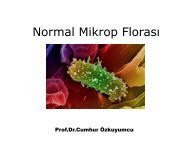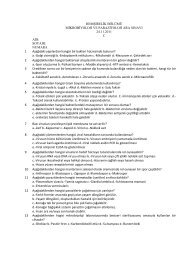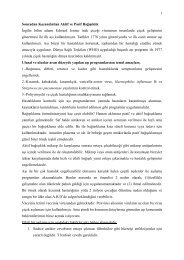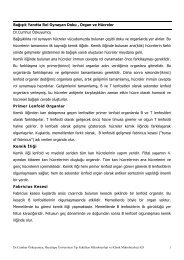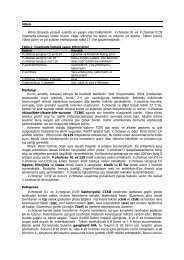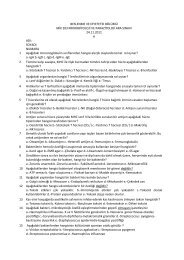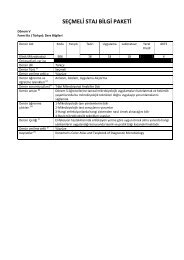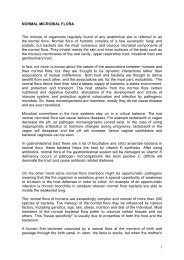anaerobic bacteria
anaerobic bacteria
anaerobic bacteria
- No tags were found...
You also want an ePaper? Increase the reach of your titles
YUMPU automatically turns print PDFs into web optimized ePapers that Google loves.
Isolation and identification of anaerobes from clinicalspecimens depend on:•Proper collection of specimens•Prompt transport to the laboratory•To perform special techniques for processing and culture
SPECIMEN COLLECTION!Avoid oxygen contact and contamination withnormal flora.• Aspirated material from deeper tissues,abscess…etc (with syringe)• Surgical drainage material (abscess)• Tissue biopsy samples• Samples collected with <strong>anaerobic</strong> swabsystemsCollection of specimens with swabs should bediscouraged
TRANSPORTATIONSpecimens should be transported to the laboratoryas soon as possible (within 10-30 mns)• Anaerobic transport systems• Anaerobe swab systems• Anaerobic liquid medium for tissue samples• Sterile screw cap tubes for large volumes of purulent material.Specimens should not be transported in syringe
DIRECT EXAMINATION :Macroscopic examination :• The foul odor andpurulence of thespecimen• Presence of blood,necrotic material andsulphure granules
DIRECT EXAMINATION :Microscopic examination :• Smear preparation• Fixation with methanol• Gram staining• Observation of PMNL’sand <strong>bacteria</strong> withdifferent morphotypes(mixed <strong>bacteria</strong>)* isimportant
CULTIVATIONInoculation of specimen :• Specimens for <strong>anaerobic</strong> culture must beinoculated onto aerobic medium along with the<strong>anaerobic</strong> media.• Inoculation of <strong>anaerobic</strong> liquid media such asthioglycolate medium is also very important forthe possibility of <strong>anaerobic</strong> incubation systemfails.
CULTIVATION :Anaerobic Media:The media must be,* supplemented with hemin and vit K ,* freshly prepared and properly stored.Solid media ;-Non-selective media• Anaerobic blood agar• Schaedler agarLiquid media ;Thioglycolate mediumChopped meat broth• Brucella agar• Columbia agar-Selective media• Phenyl ethyl alcohol agar• Bacteroides bile esculin agar
CULTIVATIONAnaerobic atmosphere*Anaerobic jar- GasPak systems• Commonly used.• The GasPak envelope is cut, placed in the jar and 10 ml of wateris put inside the kit.• The water and the chemical agent of GasPak reacts with eachother by the help of palladium catalyst placed in the jar,oxygen is removed, water and carbondioxide is generated• The atmosphere in the jar consist of 80-90 % N 2 , 5-10 % H 2 , 5-10 % CO 2 .• Rezasurin or methylen blue indicators are used to monitor<strong>anaerobic</strong> system.*Anaerobic chambers
Examination of growth:Incubation period:• At 37 C at least for 48 hrs.• Some of the anaerobes may require longer incubation upto 3 weeks.Evaluation:• The growth on <strong>anaerobic</strong> medium is compared with thaton the aerob culture plate.• Selective media are also helpful for isolation andidentification of certain species.
Identification:• Conventional methods• Commercial identification systems• Research:• Gas-liquid chromotography• MALDITOF (matrix assisted laser desorptionionisation-time of flight)• Molecular methods
Laboratory practice:On the front bench:• Pigmented <strong>anaerobic</strong> <strong>bacteria</strong>• Lecithinase activity on Egg Yolk Agar• Double zone of beta hemolysis• Thioglycolate medium• Chopped meat broth• Anaerobic jar-GasPak
Laboratory practice:On the front bench• Clostridium tetani, gram positive bacilli withterminal spore• Clostridium botulinum, gram positive bacilli withsubterminal spore• Clostridium perfringens, gram positive bacilliwith spores usually not seen• Fusobacterium nucleatum, fusiform gramnegative bacilli• Actinomyces meyeri, filamentous gram positivebacilli
Pigmented <strong>anaerobic</strong> <strong>bacteria</strong> Prevotella bivia
Laboratory practice:On each bench,there will be ready made and fixed slides forGram staining• Clostridium tetani, gram positive bacilli withterminal spore• Clostridium botulinum, gram positive bacilli withsubterminal spore• Clostridium perfringens, gram positive bacilliwith spores usually not seen• Fusobacterium nucleatum, fusiform gramnegative bacilli
Lecithinase (+)
Double zone of beta hemolysis
Thioglycolate mediumChopped meat broth
Anaerobic jarGasPak system
Clostridium tetani, gram positive bacilli with terminal spore
Clostridium botulinum, gram positive bacilli withsubterminal spore
Clostridium perfringens, gram positive bacilli withspores usually not seen
Fusobacterium nucleatum, fusiform gram negative bacilli
Actinomyces meyeriFilamentous gram positive bacilli
Gram stain• Crystal violet (1 min)• Wash with water• Lugol (1 min)• Wash with water• Alcohol (30 sec)• Wash with water• Fuchsin (30 sec)• Wash with water



